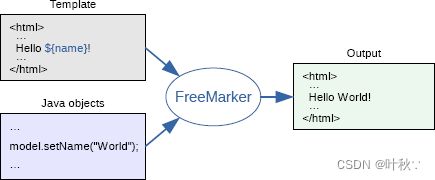深入解析Freemarker模板引擎及其在Spring Boot中的高级整合
目录
- 引言
- 1. Freemarker
-
- 1.1.什么是Freemarker
- 1.2 Freemarker模板组成部分
- 1.3.优点
- 2. Spring Boot整合Freemarker
-
- 2.1 配置
- 2.2 数据类型
- 3. 案例
- 总结

引言
Freemarker作为一款强大的模板引擎,与Spring Boot的整合能够极大地提升Web应用的开发效率和灵活性。本篇博客将深入探讨Freemarker的原理和核心概念,并重点介绍在Spring Boot项目中如何配置和应用Freemarker模板引擎。通过全面讲解与丰富示例,旨在帮助读者充分理解并熟练运用这一强大的技术组合。
1. Freemarker
1.1.什么是Freemarker
FreeMarker 是一款 模板引擎: 即一种基于模板和要改变的数据, 并用来生成输出文本(HTML网页,电子邮件,配置文件,源代码等)的通用工具。 它不是面向最终用户的,而是一个Java类库,是一款程序员可以嵌入他们所开发产品的组件。
模板编写为FreeMarker Template Language (FTL)。它是简单的,专用的语言, 不是 像PHP那样成熟的编程语言。 那就意味着要准备数据在真实编程语言中来显示,比如数据库查询和业务运算, 之后模板显示已经准备好的数据。在模板中,你可以专注于如何展现数据, 而在模板之外可以专注于要展示什么数据。
这种方式通常被称为MVC (模型 视图 控制器) 模式,对于动态网页来说,是一种特别流行的模式。 它帮助从开发人员(Java 程序员)中分离出网页设计师(HTML设计师)。设计师无需面对模板中的复杂逻辑, 在没有程序员来修改或重新编译代码时,也可以修改页面的样式。
而FreeMarker最初的设计,是被用来在MVC模式的Web开发框架中生成HTML页面的,它没有被绑定到 Servlet或HTML或任意Web相关的东西上。它也可以用于非Web应用环境中。
1.2 Freemarker模板组成部分
FreeMarker模板文件主要由如下4个部分组成:
- 文本:直接输出的部分
- 注释:使用<#-- … -->格式做注释,里面内容不会输出
- 插值:即${…}或#{…}格式的部分,类似于占位符,将使用数据模型中的部分替代输出
- FTL指令:即FreeMarker指令,全称是:FreeMarker Template Language,和HTML标记类似,但名字前加#予以区分,不会输出
FreeMarker与Web容器无关
FreeMarker与Web容器无关,即在Web运行时,它并不知道Servlet或HTTP,故此FreeMarker不仅可以用作表现层的实现技术,而且还可以用于生成XML,JSP或Java等各种文本文件。
在Java Web领域,FreeMarker是应用广泛的模板引擎,主要用于MVC中的view层,生成html展示数据给客户端,可以完全替代JSP。
总之,FreeMarker是一个模板引擎,一个基于模板生成文本输出的通用工具,使用纯Java编写,模板中没有业务逻辑,外部Java程序通过数据库操作等生成数据传入模板(template)中,然后输出页面。它能够生成各种文本:HTML、XML、RTF、Java源代码等等,而且不需要Servlet环境,并且可以从任何源载入模板,如本地文件、数据库等等。
1.3.优点
FreeMarker的诞生是为了取代JSP。虽然JSP功能强大,可以写Java代码实现复杂的逻辑处理,但是页面会有大量业务逻辑,不利于维护和阅读,更不利于前后台分工,容易破坏MVC结构,所以舍弃JSP,选择使用FreeMarker是大势所趋。当前很多企业使用FreeMarker取代JSP,FreeMarker有众多的优点,如下所示:
- 很好地分离表现层和业务逻辑
JSP功能很强大,它可以在前台编写业务逻辑代码,但这也带来了一个很大的弊端——页面内容杂乱,可读性差,这将会大大增加后期的维护难度。而FreeMarker职责明确,功能专注,仅仅负责页面的展示,从而去掉了繁琐的逻辑代码。FreeMarker的原理就是:模板+数据模型=输出,模板只负责数据在页面中的表现,不涉及任何的逻辑代码,而所有的逻辑都是由数据模型来处理的。用户最终看到的输出是模板和数据模型合并后创建的。
- 提高开发效率
众所周知,JSP在第一次执行的时候需要转换成Servlet类,之后的每次修改都要编译和转换。这样就造成了每次修改都需要等待编译的时间,效率低下。而FreeMarker模板技术并不存在编译和转换的问题,所以就不会存在上述问题。相比而言,使用FreeMarker可以提高一定的开发效率。
- 明确分工
JSP页面前后端的代码写到了一起,耦合度很高,前端开发需要熟悉后台环境,需要去调试,而后台开发人员需要去做不熟悉的前端界面设计。对两者而言,交替性的工作需要花费一定的学习成本,效率低下。而使用FreeMarker后,前后端完全分离,大家各干各的,互不影响。
- 简单易用,功能强大
FreeMarker支持JSP标签,宏定义比JSP Tag方便,同时内置了大量常用功能,比如html过滤,日期金额格式化等等。FreeMarker代码十分简洁,上手快,使用非常方便。
2. Spring Boot整合Freemarker
首先先把springboot项目启动配置好
2.1 配置
配置pom.xml
<dependency>
<groupId>org.springframework.boot</groupId>
<artifactId>spring-boot-starter-freemarker</artifactId>
</dependency>
配置yml
freemarker:
# 设置模板后缀名
suffix: .ftl
# 设置文档类型
content-type: text/html
# 设置页面编码格式
charset: UTF-8
# 设置页面缓存
cache: false
# 设置ftl文件路径
template-loader-path: classpath:/templates
# 设置静态文件路径,js,css等
mvc:
static-path-pattern: /static/**
然后在resource创建templates包,在templates包里面创建index.flt
<!DOCTYPE html>
<html lang="zh">
<head>
<meta charset="UTF-8">
<title>Title</title>
</head>
<body>
${name}
</body>
</html>
PageController
package com.yuan.springboot2.Controller;
import org.springframework.stereotype.Controller;
import org.springframework.ui.Model;
import org.springframework.web.bind.annotation.PathVariable;
import org.springframework.web.bind.annotation.RequestMapping;
/**
* @author 叶秋
* @site
* @company 卓京公司
* @create 2023-12-13 19:17
*/
@Controller
public class PageController {
@RequestMapping("/")
public String home(Model model){
model.addAttribute("name","zs");
return "index";
}
@RequestMapping("/{path}")
public String to(@PathVariable("path") String path){
return path;
}
@RequestMapping("/{dir}/{path}")
public String to(@PathVariable("dir") String dir,@PathVariable("path") String path){
return dir+"/"+path;
}
}
2.2 数据类型
在文本中确定字符串值的方法是看双引号,比如: "some text",或单引号,比如: 'some text'。这两种形式是等同的。 如果文本自身包含用于字符引用的引号 ( " 或 ')或反斜杠时, 应该在它们的前面再加一个反斜杠;这就是转义。 转义允许直接在文本中输入任何字符, 也包括换行。
${"It's \"quoted\" and
this is a backslash: \\"}
字符串类型处理:
| 方法 | 含义 |
|---|---|
| ?substring(start,end) | 截取字符串(左闭右开) |
| ?uncap_first | 首字母小写输出 |
| ?cap_first | 首字母大写输出 |
| ?lower_case | 字母转小写输出 |
| ?upper_case | 字母转大写输出 |
| ?length | 获取字符串长度 |
| ?starts_with(“xx”)?string | 是否以指定字符开头(boolean类型) |
| ?ends_with(“xx”)?string | 是否以指定字符结尾(boolean类型) |
| ?index_of(“xx”) | 获取指定字符的索引 |
| ?trim | 去除字符串前后空格 |
| ?replace(“xx”,“xx”) | 替换指定字符串 |
字符串空值情况处理:
FreeMarker 的变量必须赋值,否则就会抛出异常。而对于 FreeMarker 来说,null 值和不存在的变量是完全一样的,因为 FreeMarker 无法理解 null 值。
<#-- 如果值不存在,直接输出会报错 -->
<#--${str}-->
<#-- 使用!,当值不存在时,默认显示空字符串 -->
${str!}
<#-- 使用!"xx",当值不存在时,默认显示指定字符串 -->
${str!"这是一个默认值"}
<#-- 使用??,判断字符串是否为空;返回布尔类型。如果想要输出,需要将布尔类型转换成字符串 -->
${(str??)?string}
3. 案例
pageController
package com.yuan.springboot2.Controller;
import com.yuan.springboot2.mapper.TBookMapper;
import com.yuan.springboot2.pojo.TBook;
import org.springframework.beans.factory.annotation.Autowired;
import org.springframework.stereotype.Controller;
import org.springframework.ui.Model;
import org.springframework.web.bind.annotation.PathVariable;
import org.springframework.web.bind.annotation.RequestMapping;
import java.util.List;
/**
* @author 叶秋
* @site
* @company 卓京公司
* @create 2023-12-13 19:17
*/
@Controller
public class PageController {
@Autowired
private TBookMapper tBookMapper;
@RequestMapping("/")
public String home(Model model){
List<TBook> tBooks = tBookMapper.selectAllbook();
model.addAttribute("name","zs");
model.addAttribute("tBooks",tBooks);
return "index";
}
@RequestMapping("/{path}")
public String to(@PathVariable("path") String path){
return path;
}
@RequestMapping("/{dir}/{path}")
public String to(@PathVariable("dir") String dir,@PathVariable("path") String path){
return dir+"/"+path;
}
@RequestMapping("/del")
public String del(TBook tBook){
tBookMapper.deleteByPrimaryKey(Long.valueOf(tBook.getId()));
return "redirect:/";
}
@RequestMapping("/add1")
public String add1(TBook tBook){
return "add1";
}
@RequestMapping("/edit")
public String edit(TBook tBook){
if(tBook.getId()==null){
tBookMapper.insertSelective(tBook);
}else{
tBookMapper.updateByPrimaryKeySelective(tBook);
}
return "redirect:/";
}
@RequestMapping("/chaxun")
public String chaxun(TBook tBook,Model model){
if(tBook.getId()!=null){
TBook tBook1 = tBookMapper.selectByPrimaryKey(Long.valueOf(tBook.getId()));
model.addAttribute("tBook1",tBook1);
}
model.addAttribute("tBook1",tBook);
return "add";
}
}
add
<!DOCTYPE html>
<html lang="en">
<head>
<meta charset="UTF-8">
<title>Title</title>
<#include "common.ftl">
</head>
<body>
<form action="${ctx}/edit?id=${tBook1.id}" method="post">
<div class="form-group" >
<label for="itemName">书籍名称</label>
<input type="text" class="form-control" name="bookname" id="bookname" value="${tBook1.bookname}" placeholder="">
</div>
<div class="form-group">
<label for="itemName">书籍价格</label>
<input type="text" class="form-control" name="price" id="price" value="${tBook1.price}" placeholder="">
</div>
<div class="form-group">
<label for="itemName">书籍类型</label>
<input type="text" class="form-control" name="booktype" id="booktype" value="${tBook1.booktype}" placeholder="">
</div>
<button type="submit" class="btn btn-primary">确定</button>
</form>
<script>
</script>
</body>
</html>
index
<!DOCTYPE html>
<html lang="zh">
<head>
<meta charset="UTF-8">
<title>Title</title>
<#include "common.ftl">
</head>
<body>
${name}
<a href="${ctx}/a"></a>
<a href="${ctx}/add1">新增</a>
<#if tBooks??>
<table class="table table-striped">
<#list tBooks as b>
<tr>
<td>${b.id}</td>
<td>${b.bookname} </td>
<td>${b.price}</td>
<td>${b.booktype}</td>
<td><a href="${ctx}/del?id=${b.id}">删除</a></td>
<td><a href="${ctx}/chaxun?id=${b.id}">修改</a></td>
</tr>
</#list>
</table>
<div class="container mt-5">
</div>
</#if>
</body>
</html>
common
<#assign ctx="${springMacroRequestContext.contextPath}">
<link rel="stylesheet" href="${ctx}/bootstrap-3.4.1-dist/css/bootstrap.css">
<script src="${ctx}/jquery-3.6.1.js">
<script src="${ctx}/bootstrap-3.4.1-dist/js/bootstrap.js">
</script>
总结
总结部分将对本篇博客进行回顾,并强调Freemarker模板引擎在Spring Boot中的重要性和应用前景。通过深入的讲解和丰富的实例,本篇博客旨在帮助读者掌握Freemarker模板引擎的核心概念和应用技巧,并能够灵活应用于实际的Web开发项目中。

